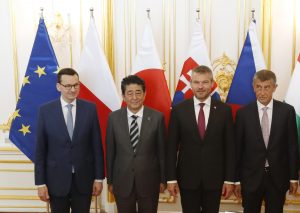Much has been written about the reinvigoration of the Japan-EU relationship after signing the strategic and economic partnership in the last few years. But Japanese rapprochement to the EU does not end in Brussels. In recent years, another European platform has been activated by Abe’s proactive policy: The Visegrad 4. The summits of the V4+Japan framework in 2018 and 2019 sparked optimism about the opportunities and possibilities of this form of cooperation. But even though there is an observable expansion to the relationship, it remains far from becoming an institutionalized framework and faces radical challenges that might make it obsolete shortly after coming to life.
The V4 relationship with Japan has some solid roots. This year, the Czech Republic and Slovakia celebrate 100 years of official relations with Japan, Poland made the connection 101 years ago and Hungary, as a part of the Austrian-Hungarian empire, 150 years back. For most of this history, however, the geographic distance and lack of common interests made cooperation shallow. In the 1950s, these newly communist countries restarted official relations that were severed by the war, but Japanese focus on its relationship with the Soviet Union (and not its components) hampered any potential for future economic or political progress.
After the Velvet revolution liberated the V4 countries from Soviet rule, Japan was among the first states to come seeking business opportunities. The greenfield investments of companies such as Suzuki in Hungary, Kia in Slovakia and Toyota in the Czech Republic significantly helped their newly opened market economies. Even in 2019, in all of these countries, Japanese investment marked first (Czech Republic, Poland) or second (Slovakia, Hungary) position from Asia (if second, then after South Korea, which only recently upped its investment in the region).
But increasing investments in the V4 countries were until recently not matched by an increase in political ties. Prior to the V4 joining the European Union in 2004, there was only very shallow contact, with the only exception when Prime Minister Junnichiro Koizumi visited the Czech Republic and Poland during his 2003 trip to Europe. But since Shinzo Abe came to office, his proactive foreign policy and “arc of freedom and prosperity” paved a way for further enhancement of ties.
In 2013, Abe met the V4 prime ministers in Warsaw in a first official summit of the newly established V4+Japan framework. This loosely tied, noninstitutionalized, framework promoted cooperation on trade and investment, scientific research, distribution of overseas development assistance (ODA), and cooperation in approaching the western Balkans. The expectations of further promotion of this cooperation were quite high. It was signed one year after China proposed the 16+1 (17+1) instrument to get closer to Central and Eastern European countries. Given Abe’s incentive to counter Chinese presence around the world and the V4’s insistence on using the framework to “be heard,” few expected the coordination effort to go south.
But although there were two further summits in 2018 and 2019, not much has been done to transform this loosely tied cooperation into something more substantive. There are several reasons why. First, there is visible interest on the Japanese side to deal primarily with the European Union, and only secondarily with the V4. Japan’s pre-accession approach to the V4 was radically different from the period when the V4 countries joined the union and its single market. But while the V4 remain members of the EU, their sometimes conflicting political stances toward European policies and directives take them to the fringes of the main currents of European integration. Simply put, although Japan would appreciate more integration of the V4 and the EU, the V4 seems to want less of it.
Second, there are grave differences between the V4’s strategic cultures, threat perceptions, and general foreign policy interests. Hungary is the black sheep of the group. Prime Minister Viktor Orban’s foreign policy prefers Beijing and Moscow to Brussels and often blocks common positions. Poland’s anti-Chinese and anti-Russian attitudes are quite different, but Warsaw is at odds with the EU over its anti-democratic reforms as of late. Slovakia is perhaps the most pro-EU, especially with a new government that resulted from the March 2020 election, but is the smallest of the group and in other areas quite distinct from them. The Czech Republic is somewhere in between. Populist Prime Minister Andrej Babiš often speaks ill of the EU, but this is largely because of the EU’s threats to stop subsidizing his business group Agrofert due to Babiš’s conflict of interests. In any case, although these four countries present themselves as culturally close and politically allied, their political cultures and strategic interests do not overlap. Even worse, the similarities of their industries make them competitors for Japanese investment, which again threatens the cohesiveness of the group.
Third, there are some symbolic developments in V4 security integration (V4 battlegroups) that could be useful in promoting the V4+Japan framework (especially given that Poland and the Czech Republic were the members of the post-war commission designed to oversee implementation of the armistice between North and South Korea). But these developments lack better grounds; there is only a limited investment by the V4 countries and lack of will to promote closer defense integration, rather than cooperation.
To sum it up, although there were some advances in the V4+Japan framework, it remains underdeveloped and weak. If the V4 is really interested in changing this, closer coordination within the EU, constructive policymaking toward Brussels, and less enthusiasm toward nonexistent and unsubstantiated Chinese investment would definitely help the cause. So far, this is not visible.
Michal Kolmas is an assistant professor and deputy head of the Asian studies department at Metropolitan University Prague.

































